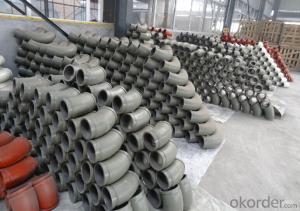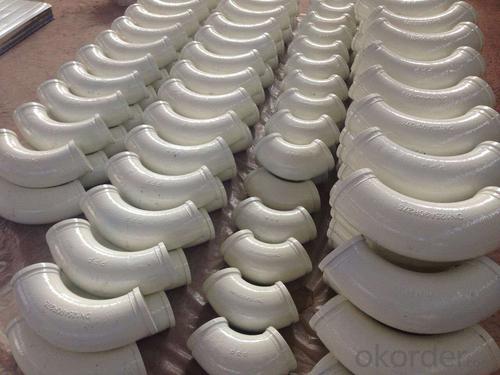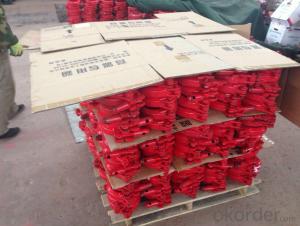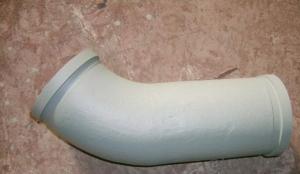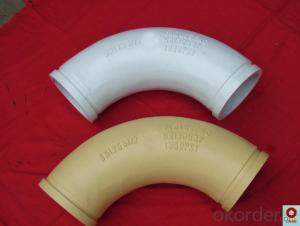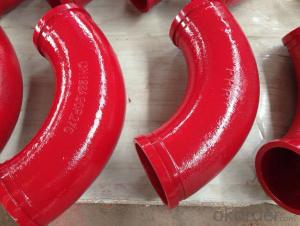CONCRETE DELIVERY ELBOW SCHWING TYPE 45DEG R275 DN125
- Loading Port:
- Tianjin
- Payment Terms:
- TT OR LC
- Min Order Qty:
- 100 pc
- Supply Capability:
- 10000 pc/month
OKorder Service Pledge
OKorder Financial Service
You Might Also Like
concrete pump elbow table
Wear-resistant Single or Double Concrete Pump Elbow | |||||||
Type | Singe Elbow | Double Elbow | |||||
Model | DN125 | DN150 | DN175 | DN125 | |||
Material | Casting Steel ,ST52 | Inside | 40Cr | Outside | |||
Size | R275*90° | R275*90°+110 | 36° | F2000 | R275*90° | R275*90°+110 | |
R275*45° | R275*90°+211 | R400*30° | A3000 | R275*45° | R275*90°+211 | ||
R275*25° | R275*90°+411 | R400*45° | 471B | R275*25° | R275*90°+411 | ||
R275*20° | R275*90°+424 | R400*30° | 571B | R275*20° | R275*90°+424 | ||
R275*15° | R275*45°+170 | R488*90° | A1000 | R275*15° | R275*45°+170 | ||
R180*90° | R275*45°+310 | R500*90 | C1000 | R180*90° | R275*45°+310 | ||
R232*60° | R275*45°+310 | R280*90° | B2000 | R232*60° | R275*45°+310 | ||
R240*36° | 20°Lengthen | R240*36° | 20°Lengthen | ||||
R240*30° | 25°+740 | R240*30° | 25°+740 | ||||
R240*15° | 40°Zoomlion | R240*15° | 40°Zoomlion | ||||
R385*29° | R385*29° | ||||||
R315*33° | R315*33° | ||||||
Technic | Forged | ||||||
Average life | 25,000cubic | 50,000cubic | |||||
Appliciation | Used in concrete transport in construction work | ||||||
1.product profile:The double layer concrete pump elbow is developed by ourselves through new
technology and process.
2.characteristic:the inner layer of this concrete pump elbow undergoes heat treatment,and then the rigitiry can reach 62-65HRC.
3.characteristic:the outer layer of the concrete pump elbow possess good toughness properties
to protect the inner layer,so the security of the elbow is improved.
4.life:the experiment done abroad shows that the life of our concrete pump elbow can reach 35000-50000cbm,got the customers' praise
5.Beside the double layer concrete pump elbow,we produce all kinds of concrete pump parts,
straight pipe hose flange coupling and so on.
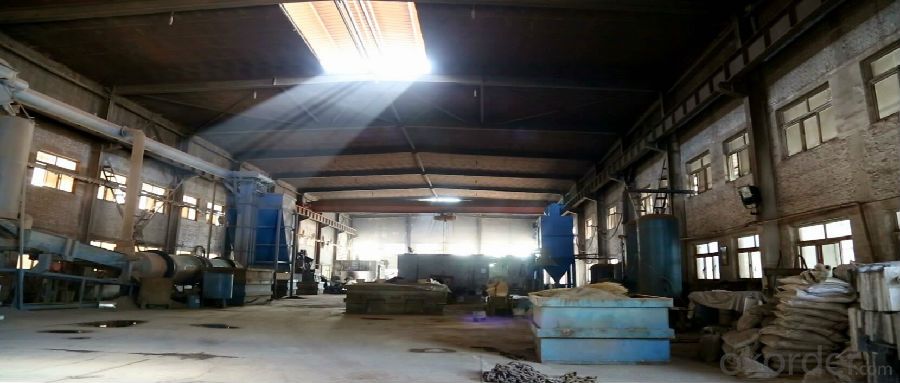
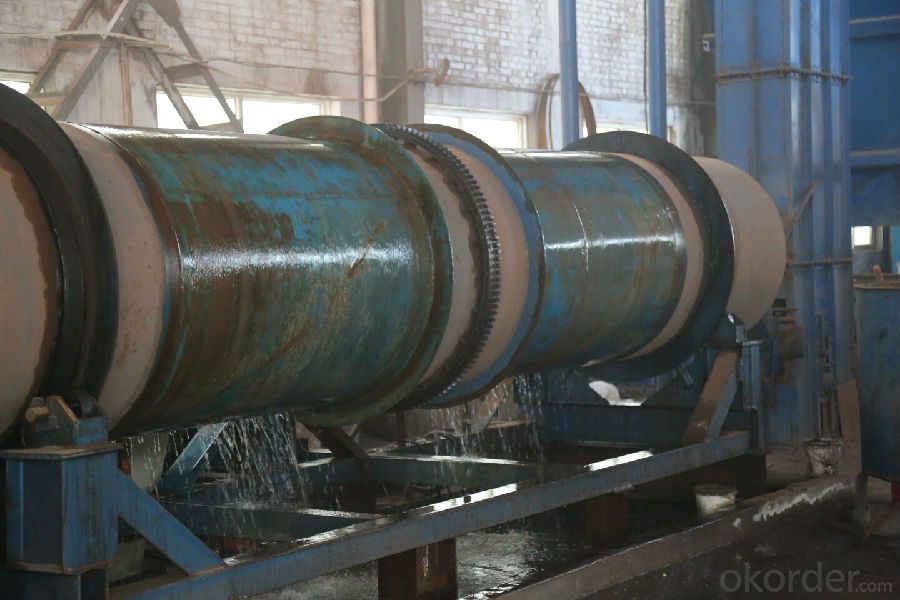

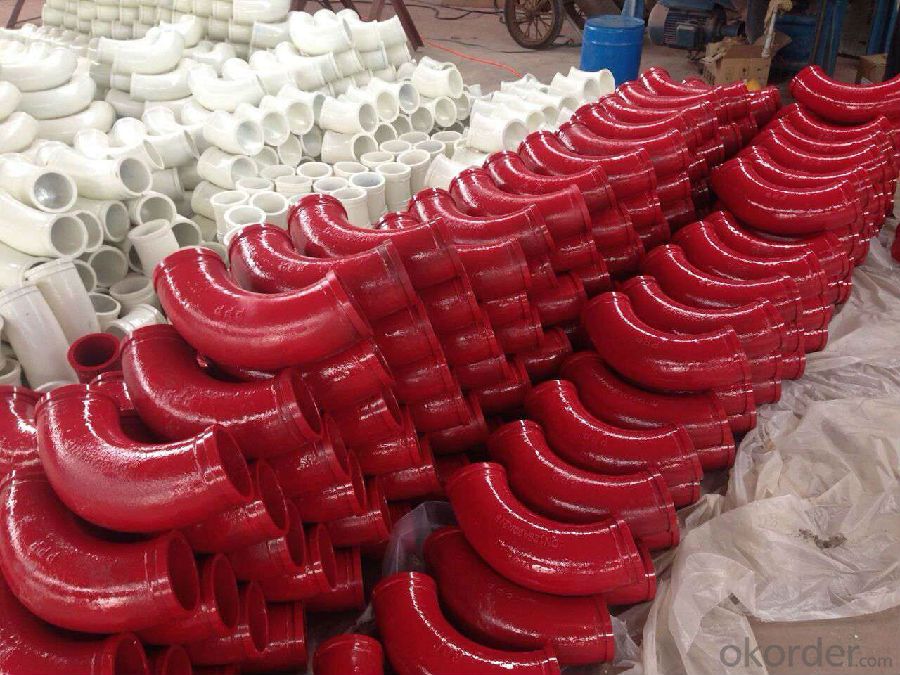
- Q: Can concrete pump spare parts be pre-assembled or pre-tested before installation?
- Yes, concrete pump spare parts can be pre-assembled or pre-tested before installation. Pre-assembling the spare parts allows for quality control measures to be taken before the actual installation process. This ensures that any defects or issues with the parts can be identified and rectified before they are installed in the concrete pump. Additionally, pre-testing the spare parts helps to ensure their functionality and compatibility with the pump system. It allows for any necessary adjustments or modifications to be made beforehand, reducing the risk of complications during the actual installation process. Overall, pre-assembling and pre-testing concrete pump spare parts is a common practice to ensure the smooth and efficient operation of the pump system.
- Q: How often should wear rings be replaced in a concrete pump?
- The replacement frequency of wear rings in a concrete pump relies on various factors such as the pump type, wear ring quality, concrete volume being pumped, and operating conditions. In essence, wear rings are components that endure substantial wear and tear due to the abrasive nature of concrete. Consequently, they will eventually require replacement to uphold the pump's efficiency and avoid potential damage to other pump parts. Typically, wear rings should be regularly inspected during routine maintenance checks. The wear patterns and extent of damage will determine if replacement is needed. In certain cases, wear rings may endure for several thousand hours of operation, while in others, replacement may be necessary more frequently. It is advisable to consult the pump manufacturer for specific guidelines on wear ring replacement intervals based on the pump model and operating conditions. They can offer recommendations based on their expertise and understanding of the pump's design and performance. Ultimately, the objective is to guarantee smooth and efficient operation of the concrete pump, minimizing downtime and maximizing its lifespan. Regular inspections and proactive replacement of wear rings when necessary will contribute to achieving this goal.
- Q: What are the functions of concrete pump truck?
- According to the structure and use of divided into drag type concrete pump, truck pump and pump car, according to the power type is divided into electric concrete pump and diesel power concrete pump
- Q: How does a hopper agitator blade ensure smooth concrete flow?
- To guarantee a seamless flow of concrete, a hopper agitator blade is employed to mix and disintegrate any clumps or air pockets in the concrete mixture. Specifically designed to be positioned inside the hopper, the blade rotates and agitates the concrete, ensuring a homogeneous and steady state. While in rotation, the blade disperses any settled aggregates at the hopper's base, preventing blockages or uneven distribution during the pouring procedure. This uninterrupted mixing action guarantees that the concrete remains well-blended and effortlessly pours out of the hopper. Furthermore, the agitator blade aids in breaking up any air bubbles that may have formed within the concrete mixture. These air bubbles can compromise the structural integrity of the concrete and lead to an uneven final appearance. By agitating the concrete, the blade effectively releases trapped air, promoting a consistently dense mixture. In essence, a hopper agitator blade guarantees a seamless flow of concrete by effectively blending the mixture, breaking apart any clumps or air pockets, and fostering a uniform composition. This ensures that the concrete pours smoothly and evenly during the pouring process, resulting in a top-notch end product.
- Q: What is the function of a concrete pump hopper grate clamp?
- A concrete pump hopper grate clamp serves the purpose of securing the hopper grate on a concrete pump. This device ensures that the hopper grate remains fixed in position, preventing the entry of large debris and foreign objects into the pump system. The clamp is specifically designed to tightly hold the hopper grate, guaranteeing its stability during the pumping process. Its role is to preserve the integrity of the pump system and avert any potential damage or blockages caused by unwanted materials. In summary, a concrete pump hopper grate clamp functions as a dependable and secure method to maintain the hopper grate in place, facilitating efficient and seamless concrete pumping operations.
- Q: If the concrete pump valve jam how to judge and deal with?
- The valve plug is formed gradually, the main reason is that after the completion of concrete pump, no time to use high-pressure water washing, resulting in concrete residue in the tube after a considerable period of time, gradually thickening, accumulation of consolidation, resulting in congestion.
- Q: What is the function of a concrete pump hydraulic accumulator?
- A concrete pump hydraulic accumulator serves a crucial function in the operation of a concrete pump. Its main purpose is to store and release hydraulic energy, which helps in maintaining a constant and smooth flow of concrete during pumping operations. The hydraulic accumulator acts as a pressure storage tank that is connected to the hydraulic system of the concrete pump. When the pump is not in operation, the accumulator stores pressurized hydraulic fluid. This stored energy can be released when required, such as during the pumping process, providing an additional power source to supplement the main hydraulic system. During concrete pumping, the accumulator assists in maintaining a consistent flow of concrete by compensating for pressure fluctuations in the hydraulic system. It serves as a buffer, absorbing any excess pressure and releasing it back into the system when needed. This helps in preventing pressure spikes or drops, which could otherwise lead to irregular concrete flow or even damage to the pump. Furthermore, the hydraulic accumulator also plays a role in reducing energy consumption and enhancing the overall efficiency of the concrete pump. By storing and reusing energy, it minimizes the need for constant power supply from the main hydraulic system, thereby reducing the load on the pump's engine and improving fuel efficiency. Overall, the function of a concrete pump hydraulic accumulator is to store and release hydraulic energy, ensuring a consistent and smooth flow of concrete during pumping operations, while also contributing to energy efficiency and protecting the pump from potential damage.
- Q: How does the concrete pump work?
- Pump in place should be flat and solid, without obstacles around, no overhead transmission line. The pump shall not be parked on the slope.
- Q: Can concrete pump spare parts be repaired on-site, or should they be sent to a specialized repair facility?
- Concrete pump spare parts can be repaired on-site in certain cases, while in others it may be necessary to send them to a specialized repair facility. The decision of whether to repair on-site or send for specialized repair depends on the nature and complexity of the repair required, the availability of skilled technicians and equipment, and the time constraints of the project. In many cases, minor repairs or replacements of simple components can be carried out on-site. These may include tasks such as replacing hoses, seals, or filters, which can be done quickly and easily with basic tools and equipment. These types of repairs can often be performed by the operators or maintenance personnel themselves, without the need for specialized technicians. However, for more complex repairs or replacements, it is advisable to send the spare parts to a specialized repair facility. This is particularly true for critical components such as hydraulic cylinders, valves, or control systems, which require specialized knowledge and expertise to repair properly. Specialized repair facilities have trained technicians who specialize in specific equipment and are equipped with the necessary tools and resources to diagnose and fix complex issues. Moreover, specialized repair facilities often have access to a wider range of spare parts and can source genuine parts from the original manufacturer. This ensures that the repaired spare parts are of high quality and compatible with the specific make and model of the concrete pump. Additionally, these facilities may offer warranties on their repairs, providing peace of mind to the equipment owners. Ultimately, the decision to repair on-site or send for specialized repair depends on the specific situation and resources available. It is important to assess the complexity of the repair, the availability of skilled technicians, and the potential impact on the project timeline before deciding on the most appropriate course of action.
- Q: What are the common causes of overheating in concrete pump spare parts?
- Concrete pump spare parts can overheat due to various common causes. One primary reason is improper lubrication, which results in increased friction and overheating of the pump's moving parts like bearings and pistons. To prevent this, it is essential to regularly inspect and maintain the lubrication system to ensure smooth operation. Excessive use or continuous operation without breaks is another common cause of overheating. Concrete pumps have a designated workload, and surpassing it or neglecting proper rest periods can lead to overheating of the components. To avoid this, it is crucial to adhere to recommended operating guidelines and periodically allow the pump to cool down. Additionally, overheating can occur due to clogged or blocked cooling systems. The cooling system in a concrete pump regulates temperature by circulating coolant around vital parts. If the system gets clogged or the coolant level is insufficient, overheating may occur. Regular inspection, cleaning, and maintaining appropriate coolant levels can prevent this issue. Inadequate ventilation is also a common cause of overheating. Concrete pumps generate substantial heat during operation, and if the surrounding environment lacks proper airflow, the heat cannot dissipate effectively. This can lead to overheating of spare parts. To avoid this, it is important to operate the pump in well-ventilated areas or utilize additional cooling measures like fans or air conditioning. Lastly, a malfunctioning or damaged pump component can cause overheating. When a part such as the motor or hydraulic system does not function correctly, it places additional strain on other components, resulting in overheating. Regular maintenance and inspection of the pump's components can help identify and address any potential issues before they lead to overheating. In conclusion, preventing overheating in concrete pump spare parts requires proper lubrication, adherence to operating guidelines, maintenance of cooling systems, ensuring adequate ventilation, and regular component inspection.
Send your message to us
CONCRETE DELIVERY ELBOW SCHWING TYPE 45DEG R275 DN125
- Loading Port:
- Tianjin
- Payment Terms:
- TT OR LC
- Min Order Qty:
- 100 pc
- Supply Capability:
- 10000 pc/month
OKorder Service Pledge
OKorder Financial Service
Similar products
Hot products
Hot Searches
Related keywords

